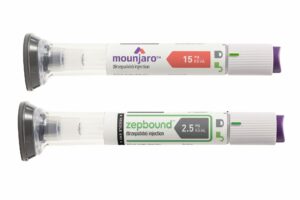Methylene blue, once primarily recognized for its use in treating cyanide poisoning, has now emerged as a promising compound with significant health benefits. This blog will explore how methylene blue supports mitochondrial health, enhancing longevity and overall vitality. We’ll delve into its mechanisms, benefits, and practical ways to incorporate it into your health routine.
Understanding Mitochondrial Health
Our mitochondria play a crucial role in producing the energy our cells need to function. Extremely sensitive to oxidative stress, maintaining mitochondrial health is essential for overall vitality and longevity.
Mitochondria, often referred to as the powerhouses of the cell, are small yet mighty organelles found within most cells in the body. These structures are responsible for generating adenosine triphosphate (ATP), the energy currency that powers cellular processes. Mitochondrial dysfunction has been linked to a multitude of health issues, from fatigue to age-related diseases and beyond. Ensuring that these cellular energy factories are functioning optimally is crucial for maintaining not just physical energy, but also cognitive function and emotional well-being. When mitochondria operate efficiently, our bodies can better convert nutrients into ATP, enabling every biological system to perform optimally. Consequently, understanding how to support and protect these critical components of our cells becomes imperative for achieving both short-term vitality and long-term health.
Mitochondrial health can be impacted by various factors such as diet, exercise, and exposure to toxins. Poor mitochondrial function can lead to decreased energy production, increased oxidative stress, and even cell death. However, maintaining mitochondrial health may help prevent or mitigate the effects of several chronic conditions, including neurodegenerative diseases, heart disease, and diabetes. This emphasizes the importance of nurturing our cellular engines. Interventions aimed at supporting mitochondrial health are gaining traction, and one such intervention worth exploring is the use of methylene blue. Enhancing mitochondrial efficiency offers a promising avenue for extending health span, enabling us to enjoy more years of high-quality life.
What is Methylene Blue?
Methylene blue is a synthetic dye that has been used in medicine for over a century. Originally employed as a treatment for malaria, its potential as a mitochondrial enhancer has sparked new interest.
First synthesized in 1876, methylene blue has a long and storied history in medical applications, ranging from its use as an antimalarial agent to serving as a vital stain in diagnostic procedures. So what is it that continues to draw the scientific community’s attention to this century-old compound? Beyond its vivid blue hue, methylene blue possesses unique bio-active properties that have increasingly captured interest, especially in the context of cellular health and longevity. Researchers have uncovered methylene blue’s ability to penetrate cell membranes and accumulate in mitochondria, where it acts as a redox buffer. It’s this unique capability to shuttle electrons within the mitochondrial electron transport chain that has poised methylene blue as a compound worth revisiting in modern-day health discussions.
One fascinating aspect of methylene blue is its dual role as both a dye and a medical agent. Known chemically as methylthioninium chloride, it has been applied broadly due to its remarkable properties. In the realm of medicinal chemistry, methylene blue has emerged as a versatile player in the treatment of certain blood disorders like methemoglobinemia, a condition where hemoglobin can’t carry oxygen effectively. Beyond these applications, recent studies have provided increasing evidence of methylene blue’s potential to influence mitochondrial health. By improving mitochondrial function, methylene blue may serve as a conduit to enhance cellular energy levels, cognitive capacities, and even offer protective benefits against cognitive decline. This has certainly warranted its consideration as a tool not limited to the medical lab but also potentially practical applications in daily health regimens.
How Methylene Blue Supports Mitochondrial Function
Methylene blue improves mitochondrial efficiency by acting as an electron donor, supporting the electron transport chain, and reducing oxidative stress. These actions help optimize energy production and cellular health.
At a cellular level, one of the key mechanisms through which methylene blue enhances mitochondrial function is its ability to serve as an alternative electron carrier in the mitochondrial electron transport chain. This means that methylene blue can bypass specific dysfunctional components, such as complex I, and directly facilitate electron transfer from NADH to cytochrome c, boosting overall ATP production. This rerouting at the electron transfer chain not only enhances the biogenesis of ATP but also assists in reducing the buildup of reactive oxygen species (ROS), counteracting oxidative damage—one of the hallmarks of aging and various chronic diseases. By mitigating oxidative stress, methylene blue supports the preservation of mitochondrial integrity, offering a potentially powerful intervention for maintaining cellular resilience.
Another layer of benefit with methylene blue lies in its capacity to preserve and potentially boost cognitive functions by enhancing neuronal resilience. Oxidative damage often correlates with cognitive degeneration, yet methylene blue’s antioxidant properties appear to counteract this. Studies suggest that methylene blue enhances neural health at the mitochondrial level, which could be beneficial in age-related cognitive decline seen in disorders such as Alzheimer’s and Parkinson’s disease. This ability to fortify the brain’s energy landscape positions methylene blue as a potential neuroprotective agent. Moreover, methylene blue inspires research into how we might redefine longevity itself—not merely in years, but through quality, cognitive sharpness, and sustained vigor.
Potential Health Benefits of Methylene Blue
By enhancing mitochondrial function, methylene blue may contribute to increased energy levels, improved cognitive function, and potentially slowing the aging process. These benefits make it an intriguing option for those looking to boost their overall health.
Beyond supporting mitochondrial function, what makes methylene blue particularly notable is its broad spectrum of benefits for overall health and longevity. At the forefront is its potential to elevate energy levels—essential for both physical activity and mental clarity. In enhancing mitochondrial efficacy, methylene blue effectively contributes to better stamina and endurance. Those combating chronic fatigue syndromes may find its properties especially promising. Furthermore, the positive impacts on cognitive performance are a key attraction. Memory, focus, and even mood may benefit from methylene blue’s capabilities as a neuro-enhancer, offering compelling support in preserving mental acuity over time.
Interest in methylene blue also extends to its potential skin benefits, largely due to its antioxidant attributes. Research indicates that methylene blue’s application could slow down the visible signs of aging such as wrinkles and skin dryness by encouraging collagen production and enhancing skin elasticity. It combats the external damages instigated by factors like UV radiation and air pollution. Moreover, individuals exploring ways to counteract the cellular underpinnings of aging will appreciate how methylene blue may extend beyond beauty benefits to encompass wider systemic impacts, heralding it as a compound of profound rejuvenating potential.
Safe Usage and Considerations
While methylene blue shows promise, it’s important to use it safely. Consulting with a healthcare professional, understanding proper dosages, and considering individual health conditions are essential steps before incorporating methylene blue into your routine.
Safety should always be paramount when exploring new health interventions such as methylene blue. Though methylene blue is generally regarded as safe, especially in lower doses, certain precautions should be noted. For instance, it can interact with medications that influence serotonin levels, hence those on antidepressants should proceed with caution. Higher doses also pose risks of side effects, including nausea and urinary changes—underscoring the importance of dosage management. Individuals with specific health conditions, like G6PD deficiency, and expecting mothers should avoid methylene blue due to potential adverse reactions. Personalized guidance from healthcare providers can ensure that its integration into therapeutic or wellness regimens unfolds safely.
When it comes to incorporating methylene blue into one’s health regimen, understanding dosage and formulation options is crucial. Methylene blue can be administered in various forms—ranging from oral capsules to topical creams. The choice depends on individual health goals and preferences. Starting with low doses, often between 0.5 to 2 mg per kilogram of body weight, is recommended. It’s essential to adjust accordingly based on personal response and ongoing consultation with health professionals. For those eager to delve into its rehabilitative roles, compounded methylene blue preparations might offer tailored solutions aligned with unique health needs—merging potential benefits with precise applications.
Embracing the Blue: A Step Towards Vibrant Health
Methylene blue’s effects on mitochondrial health and longevity present exciting possibilities for those seeking to enhance their well-being. While more research is needed, understanding its potential benefits and safe usage can be an empowering step towards a more vibrant and healthy life.














12 Responses
Your blog post has inspired me to delve deeper into this topic. Thank you for igniting my curiosity!
As someone who’s new to this topic, your blog post was incredibly informative. Thank you for breaking it down in such an easy-to-understand way.
Your blog post challenged my assumptions and forced me to reevaluate my beliefs. Thank you for broadening my horizons.
This article was exactly what I needed. I’ve been struggling to understand the topic, but your clear and detailed explanation made it so much easier.
Your blog post was exactly what I needed to hear today. Thank you for the gentle reminder to practice self-care.
This is a topic I’m always interested in, thanks for covering it.
Your blog post was exactly what I needed to read today. It’s amazing how much insight you’ve packed into just a few paragraphs.
Your blog post resonated with me on so many levels. It’s comforting to know that others share my perspective on this topic.
Your writing has a way of resonating with me on a deep level. It’s clear that you put a lot of thought and effort into each piece, and it certainly doesn’t go unnoticed.
Your writing is a true testament to your expertise and dedication to your craft. I’m continually impressed by the depth of your knowledge and the clarity of your explanations. Keep up the phenomenal work!
I do believe all the ideas youve presented for your post They are really convincing and will certainly work Nonetheless the posts are too short for novices May just you please lengthen them a little from subsequent time Thanks for the post
Your blog is a constant source of inspiration for me. Your passion for your subject matter is palpable, and it’s clear that you pour your heart and soul into every post. Keep up the incredible work!